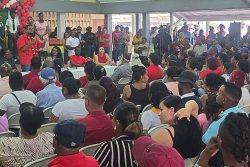What was clear from the Ministry of Public Works’ end of year press conference is that there are a number of infrastructure projects that are suffering serious delays. It is a running theme since 2020 and points to structural capacity issues both in the public and private sectors.
Among those pointed out by Minister Edghill are the Cemetery Road and Conversation Tree expansion projects. These are very modest in nature and technically of little difficulty. They were started in August 2022 but remain unfinished 18 months later.
Another example is the Schoonord to Crane bypass on the West Demerara, a road of a mere 4.1 km. The contracts were signed in September 2022 with Minister of Housing and Water Collin Croal warning the contractors, “We expect you to deliver as you promise. The people of Region Three will be watching you.” The President made a high profile visit in July during which he was promised by each of the contractors that they would be finished by October 25. Now we hear the new completion date is the end of February. This may still not be achievable in part – and quite ironically – since the contractors struggle to bring material across the river because of the same congestion the bypass is meant to relieve.
The Linden-Mabura highway contract is one of four sections to be executed as part of creating a 450 km link from a proposed deep-water harbour to Northern Brazil allowing for the movement of goods back and forth.
It’s a great idea with the potential to diversify our economy and develop the interior. Getting it done will be hard. A US$190M contract was signed in May 2022 with the Brazilian company Construtora Queiroz Galvao S.A.. This was for the first stage from Linden to Mabura, a distance of 121km.
The ministry in its end of year press conference reported that “2,835 metres of drains have been completed, as well as 18,960 metres of cement stabilized sub-base, and 16,330 metres of asphaltic concrete.” Maybe they think putting the progress in metres makes it sound more impressive but it looks like at most 16 km has actually been paved. At this rate this stage of the project may be finished by 2030.
Another project that is behind schedule is the New Demerara Harbour Bridge. Signed in May 2022 with China Railway and Construction Corporation Limited at a cost of US$260M, the project was supposed to be completed in 24 months from the date of signing after which the company will pay a fine of US$15K as agreed in the contract – reduced from US$25K. Some progress has been made but it is simply not possible for the bridge to be completed in the next five months. By all accounts we are looking at the bridge being useable by Q3 2025.
All of these projects suffer from the same maladies. A government with its pockets full trying to do too much too quickly, using contractors who are often inexperienced and under equipped both in machinery and labour. Accusations abound of contracts awarded based not on capability but “contacts”. There are also serious concerns about the financial viability of at least one foreign contractor who owes tens of millions to suppliers and is late on its payroll obligations.
Additionally there is a shortage of material be it sand or aggregate and just as importantly the ability to move it from point A to point B. This begs the question, what have the companies who were awarded quarry licences been doing since 2021?
That said, one can expect all these projects to eventually be finished.
However the project the nation should be most concerned about is the Wales Gas to Energy project. This is because of the massive expense involved – US$759M for the plant itself, an additional $1B for the pipeline and US$159M for transmission upgrades – and its importance to Guyana’s long-term development.
It appears to be the brainchild of VP Bharrat Jagdeo who unfortunately has a penchant for botched brainchilds from his Skeldon sugar factory which sunk GuySuCo into a terminal quagmire of debt to the expansion of the Cheddi Jagan Inter-national Airport which he rushed into signing a loan for, only for it to take some 11 years to complete.
Now we come to the power plant whose choice of location at Wales was always highly questionable. Subsequent information suggests there are geo-technical challenges. The general consensus among those involved with the project is that it is behind schedule with the median estimate for completion being 2026.
However as late as May 2023 Mr Jagdeo said…”the timeline for the project has not been affected. The project is expected to be delivered by the end of 2024….There is no cause for shifting that timeline at this point in time.”
It is rather hard to see how, when the US$660M loan from the US Export Import Bank has not even been approved. Back in May 2023 Mr Jagdeo had said he was confident it would be and hinted that the delay might be caused by unpatriotic Guyanese “naysayers”.
As late as last month the loan had still not come through but Mr Jagdeo was hopeful, having recently had “a great meeting” with the bank’s president.
With no loan, the contractor CH4/Lindsayca cannot order the turbines from the manufacturer Siemens for what is said to be an initial 150 MW open cycle system rather than the full 300 MW promised. Let’s not even bring up the other grandiose projects of plastic, chemical and fertiliser spinoffs.
Does Mr Jagdeo still hold to his December 2024 deadline?
As for how much we will pay for electricity, in 2021, when Mr Jagdeo was “selling” the project he had claimed “the price per kilowatt per hour of electricity could be reduced by about 80% when the project comes on stream…as low as six to seven cents…” (Guyana Chronicle February 10 2021).
His tariff promise has since been quietly revised to 50% of current levels but are we really to believe him? After all he had promised Skeldon would reduce the cost of producing sugar to 12 cents per lb. There are several factors that suggest he may not be able to keep even this promise. With the delays, the cost of the project will inevitably have to increase. Not only that, the pipeline to the plant looks like it will be delivered to Wales on time. Exxon’s CEO Alistair Routledge is quoted as saying “We’re on track for completion of the pipeline by the end of 2024, in line with the commitment that we made.” At what point will Guyana be required to pay for gas it cannot yet use as part of its “take or pay” contract of US$55M annually for 20 years? After all, the consortium is not running a charity; it has share-holders to answer to and must recoup its costs.
Not only that, we constantly hear how Guyana is growing. If the non-oil sector continues at the same rate of some 30% over the past three years, it will need much more electricity in the coming two years. How many second hand container generators can one country buy? And will the cost of these be included in calculating the final tariff after the Wales plant is complete since many of these obsolete generators will be considered sunk costs?
The opposition would do well to start asking questions in the National Assembly. What we do not want is a worse repetition of Skeldon.








